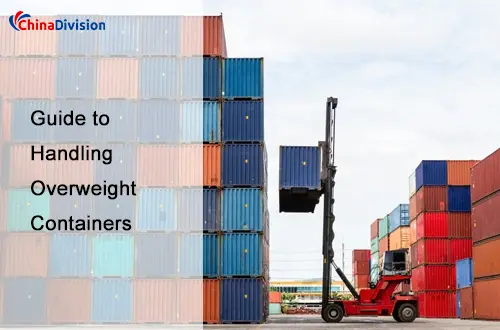What Are the Risks and Solutions for Container Overweight?
Overweight containers are a common problem, but if not handled properly, they can lead to serious consequences, including cargo delays, additional costs, and even legal issues. The maximum weight limit (MAX GROSS) is marked on the opening door of each container, indicating that the total weight of the container and the cargo must not exceed this limit.
Table of Contents
This article will deeply analyze the policy restrictions, overweight handling solutions, and risk avoidance strategies for overweight containers in international logistics, helping B2B companies and e-commerce sellers to accurately control logistics costs.
The weight limit imposed by shipping companies on containers is essentially a balance strategy between space and weight: each ship has fixed space and load limit. If a route has "more heavy cargo and less space", the shipping company will charge an overweight surcharge for overweight containers to make up for the loss of space (generally starting from 1 ton overweight, and the increase on popular routes is as high as 200-500/container).

Risks and consequences of overweight containers
Damage to the container
There is a maximum weight limit on the opening door of each container. This means that the total weight of your cargo and the container cannot exceed this value. If this weight limit is exceeded, it may cause deformation of the container, detachment of the bottom plate, bending of the top beam, and other damages. All losses caused by this will be borne by the loader.
Terminal refusal to accept
At present, most professional container terminals are equipped with automatic weighbridges. If the container loading exceeds the weight limit of the container, the terminal will refuse to accept the container. This will not only cause cargo delays, but may also incur additional storage costs.
Additional costs
The weight policy of each shipping company is different, but the general standard is not to limit the damage to the container. Considering the balance between space and weight, each container ship has certain space and weight limits. If the cargo is overweight, the shipping company may charge additional freight or even refuse to load.
What are the types of overweight and coping strategies?
Shipping company weight limit
The shipping company's weight limit policy varies from route to route, and the core principle is "not to damage the container". When the space and weight are unbalanced, the shipping company may charge an overweight surcharge; the weight limit standard may be lowered during the overload period.
Coping plan
This problem can be solved and avoided by confirming the route weight limit in advance to avoid additional costs, or choosing a suitable container type, such as a heavy cabinet, to reduce the risk of overweight, or optimizing the packing plan and reasonably distributing the weight of the cargo. Negotiate with the shipowner to pay the overweight fee to ensure normal transportation.
Port area weight limit
The port area weight limit is determined by the terminal machinery and equipment, and the shipping company will inform the specific requirements in advance.
Coping plan
Confirm the weight limit with the port in advance to avoid obstruction to port entry, or use professional logistics service providers, such as Chinadivision, to ensure that the cargo meets the port requirements. If the cargo is found to be overweight when entering the port, it is necessary to negotiate with the port area to pay the overweight fee and labor handling fee, or unload the container and reload it.
Highway weight limit at the destination port
The US highway transportation weight limit is strict (such as 17.3 tons for small cabinets and 19.5 tons for large high cabinets). Overweight may result in fines, unloading or return by the original route.
Response plan
Plan the transportation route in advance to ensure that it meets the highway weight limit at the destination port, or use batch transportation to avoid overweight of a single cabinet, and reasonably plan the cargo weight and box division plan. If the overweight at the destination port is within a certain range, paying a fine can solve the problem; if the overweight is serious and the cranes along the way cannot load, it may be necessary to unload at a nearby port or return by the original route.
Overweight box selection
If the cargo is indeed overweight, you can choose an overweight box (heavy cabinet), but you need to pay a weight selection fee (usually the same price as the designated cabinet fee). This solution is suitable for a small amount of overweight cargo, but you need to weigh the cost and transportation efficiency.
Preventive measures and optimization suggestions
Accurate weight management
Before packing, ensure that the weight of the cargo is accurate.
Choose the right container
If the cargo is indeed overweight, you can choose an overweight container. Although the weight selection fee will increase, it can avoid subsequent overweight problems.
Optimize cargo loading
By optimizing the cargo loading method, reduce unnecessary space waste and ensure that the cargo weight is evenly distributed.
Real-time monitoring and adjustment
During the transportation process, monitor the cargo weight and transportation status in real time and adjust the transportation plan in time.
Chinadivision solution: professional team escort throughout the journey
Facing the problem of overweight containers, Chinadivision provides one-stop international order fulfillment services:
Precise weight limit management
According to the policies of shipping companies, ports and destination ports, plan the cargo weight and box division plan in advance to avoid overweight risks.
Overweight emergency handling
In case of overweight, the professional team responds quickly and communicates efficiently with shipping companies and ports to reduce losses.
Global logistics network
The logistics network covering major trading countries ensures that the cargo is transported in compliance with regulations and arrives at the destination quickly and safely.
Why choose Chinadivision?
Precise weight management: Provide professional weighing services to ensure that the cargo weight meets the requirements.
Optimized loading planning: Provide professional loading planning services to help you optimize cargo loading.
Real-time logistics monitoring: Through advanced logistics management systems, real-time tracking of cargo status ensures transparency and control of the transportation process.
Rich experience: More than 10 years of experience in the field of international logistics, familiar with global weight limit policies and transportation rules.
Cost optimization: Reduce overweight surcharges and transportation costs through reasonable box division and route planning.
Efficiency guarantee: Professional team follows up throughout the process to ensure that goods are delivered on time and in compliance with regulations.
Overweight containers are an issue that needs to be taken seriously, but it can be effectively avoided and resolved through professional management and services. As a professional international logistics fulfillment service provider, Chinadivision provides intelligent warehousing, global distribution, and order fulfillment optimization to help companies optimize the supply chain and ensure that goods are delivered to their destinations safely, in compliance, and efficiently. Take action now and make Chinadivision your international logistics partner!





